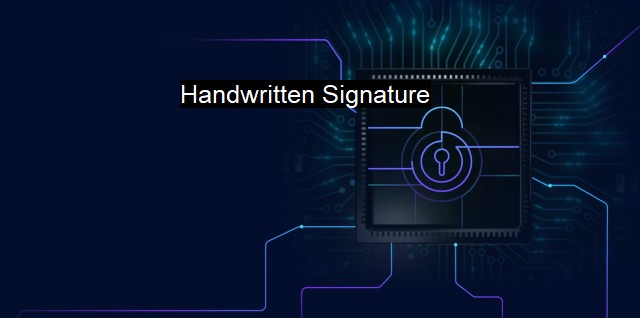What is Handwritten Signature?
The Significance of Handwritten Signatures in Cybersecurity and Antivirus: Past, Present, and Future Implications
A "Handwritten Signature" bears exceptional significance in both the physical and digital domains. In traditional terms, it refers to a person’s unique writing style scribbled on a document to identify themselves or approve the said document. This concept holds true in the context of cybersecurity and antivirus applications as well, but with a tech-rooted twist.In cyber terminology, a "Handwritten Signature" is a sequence of bit patterns or characteristic byte strings which uniquely identify a specific file, malware, or a virus. In general, cybersecurity solutions use these signatures to recognize and deal with harmful digital entities in much the same way an eye identifies an individual by fingerprints.
The idea of applying handwritten signatures to cybersecurity evolved with the growing number of destructive cyber activities, pushing for the development of antivirus software equipped with highly sophisticated guarding mechanisms. these mechanisms work as security personnel, with these handwritten signatures being the ID cards they base their response on.
To understand how it works, we first need to establish that all digital files, including the malicious ones, have distinct properties or pieces of codes. Antivirus applications are programmed to scan these properties stealthily like a surveillance camera operating 24/7 and trigger an immediate response in case they bear resemblance to any harmful signatures registered in their database.
These signatures are special codes built to match the DNA of cyber threats. They are expertly crafted and constantly updated as per evolving cyber threat landscapes, which makes them one of the most effective lines of defense against the notorious, ever-evolving universe of malware and viruses.
Just like in the traditional context, not every signature is always identical every time it is produced. This difficulty is chiefly encountered due to polymorphic and metamorphic viruses, which possess the uncanny ability to regularly change their signatures in a bid to stay undetected. As such, generating a handwritten signature becomes an ongoing process reliant on machine learning and algorithms designed to keep boxing in these mutable risks and alert systems are put in place subsequently.
Antivirus programs do not only actively lookout for harmful activities but also constantly learn from past experiences to improve their future performances. They deepen their database with the inclusion of every new virus variant they encounter, thus expanding their scanning power and helping secure digital systems better.
There is no universal handwritten signature. Each threat has its own signature that distinguishes it from others, which is why a database of these signatures needs to constantly be updated with every new malware species.
Thanks to the evolving digital threats, antivirus providers cannot afford to rely solely on handwritten signatures anymore. While these signatures remain an integral part of antivirus operations, many contemporary software use non-signature-based detection methods as well, such as behavior analysis wherein an antivirus keeps an eye on any suspicious behavior exhibited by unknown files.
For instance, if a browser plugin tries to access system files or a text document requests network access, the antivirus steps in to thwart off the potential risk. Thus broadening the defensive line beyond just the signature-based detection mechanism.
The role "Handwritten Signatures" play in cybersecurity and antivirus field crucial and continues to be a significant part of cyber defenses for risks identification and prevention. Notwithstanding its importance, it couldn’t entirely replace risk identification measures that proactively observe files’ behaviors. Together, they assure that every hidden risk is timely assessed, and the integrity of digital files and networks remains unimpaired. Constant vigilance and keen watchfulness, bolstered by lessons drawn from diverse virus and malware experiences, are what stand between secure and potentially breachable systems in cybersecurity.

Handwritten Signature FAQs
Are handwritten signatures secure in the context of cybersecurity and antivirus?
Handwritten signatures may be considered secure depending on the context in which they are used. However, they can be forged or copied, which can lead to fraudulent activities. It is best to use digital signatures that are more secure and can be verified using cryptographic algorithms.Can antivirus software detect forged handwritten signatures in documents?
Antivirus software may not be able to detect forged handwritten signatures as it does not work the same way as signature verification algorithms. However, antivirus software can detect malware that may be used to create or distribute fraudulent documents containing forged signatures.Can I use my handwritten signature for online transactions securely?
Handwritten signatures may not be the most secure way to authorize online transactions as they can be easily copied or forged. It is recommended to use digital signatures that are more secure and cannot be tampered with.What are the advantages of using a digital signature over a handwritten signature?
Digital signatures are more secure than handwritten signatures as they use cryptography to ensure authentication, integrity, and non-repudiation of documents. They can also be easily verified and can be used to sign documents digitally, eliminating the need for printing and scanning.| | A | | | B | | | C | | | D | | | E | | | F | | | G | | | H | | | I | | | J | | | K | | | L | | | M | |
| | N | | | O | | | P | | | Q | | | R | | | S | | | T | | | U | | | V | | | W | | | X | | | Y | | | Z | |
| | 1 | | | 2 | | | 3 | | | 4 | | | 7 | | | 8 | | |||||||